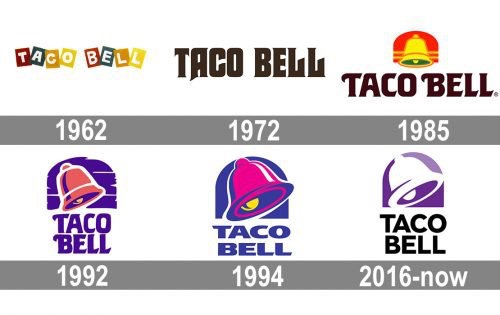Taco Bell was founded by Glen Bell, who opened his first hot dog stand ‘Bell’s Drive-In’, in San Bernardino in 1948
His family name, carried down through the ages, is a thinly-veiled reference to Ba’al:
Here’s the history of the Taco Bell logo:

(Taco Bell logo, 1962 to present)
Can you see the reptile-eye motif on the clapper of the bell, masquerading as a reflection? Can you see how they removed it in 2016, because too many rubes were getting wise?
“Several Cumbrian hills received their names from the sacrifice of the Beltain, of which they were the sites. Of these the highest is Hill Bell, the hill of the Baal, or Beltain, in Westmoreland; Bell Hill, near Drigg in Cumberland, confirms this etymology of the name. Besides these we have Bells and Green Bells in Westmoreland, and Cat Bells, Derwentwater. Yevering Bell, Northumberland and Baal Hills on the Yorkshire moors, are further corroborative the origin of the name, and the precise nature of the worship there practiced.”
From “Cumberland & Westmoreland, Ancient and Modern: The People, Dialect, Superstitions and Customs”, by Jeremiah Sullivan, 1857
“The devil’s agents may be of flesh and blood, may they not?”
Sherlock Holmes, from “The Hound of the Baskervilles”, by Sir Arthur Conan Doyle, 1902
THE DATA
In 2017, Ford invested $1 billion in the self-driving startup Argo AI, and Volkswagen later joined with a $2.6 billion investment.
From 2021 to 2022, autonomous vehicle investments decreased by 58%, from $9.7 billion to $4.1 billion.
From 2021 to 2022, robotics investments decreased by 33%, from $18 billion to $12 billion.
From 2021 to 2022, Americans who were afraid of self-driving cars increased by 26%, from 54% to 68%.
From 2021 to 2022, the percentage of the public who are not comfortable at all with self driving vehicles increased by 6%, from 69% to an all-time high 73%.
Civilscience.com author Sara Schreiber omitted the percentage, and referred to it as “decreased by four percentage points”.
From 2021 to 2022, Americans who were afraid of self-driving cars increased by 1.9%, from 54% to 55%.
In 2022, after investing almost $4 billion, Ford and Volkswagen shut down their self-driving startup Argo AI.
Ford said “it didn’t attract new investors”, and that "profitability was a long way off.”
From 2022 to 2023, Americans who would trust a self-driving vehicle decreased by 40% , from 15% to 9%.
From 2022 to 2023, Americans who were afraid of self-driving cars increased by 23.6% , from 55% to 68%.
From 2022 to 2023, the 23.6% increase in Americans who were afraid of self-driving cars was 1,142% greater than the 1.9% increase from 2021 to 2022.
The great positive change is increasing hyper-exponentially, going forward in time.
THE ARTICLES
On January 10, 2023, civilscience.com said “Interest in Self-Driving Cars Slows to Pre-Pandemic Levels (Plus More Insights Fueling the Industry)”.
Where author Sara Schreiber said “slows to pre-pandemic levels” because, as a propagandist, she knows that sixty to seventy percent of readers only read the headlines, and her hedging generality goes a long way toward “compartmentalizing” awareness of the exponential speed and scope of the increase in fear and loathing of self-driving cars which she is attempting to obfuscate.
Using a time-honored propaganda technique, Sara “buried” the data in an unsearchable table below, and didn’t do any analysis on it. Those are examples of the propaganda technique known as “compartmentalization”.
So, I had to do the math to learn that, from 2021 to 2022, the percentage of the public who are not comfortable at all with self-driving vehicles increased by 6%, from 69% to an all-time high 73%. Civilscience.com author Sara Schreiber omitted the percentage, and referred to it as “decreased by four percentage points”.
On March 2, 2023, newsroom.aaa.com said "AAA: Fear of Self-Driving Cars on the Rise ".
Directly in the face of retreating autonomous technology, Public Relations and Content Manager Brittany Moye goes on to say “Drivers Increasingly Anxious as Autonomous Technology Advances”.
Brittany said “on the rise” because, as a propagandist, she knows that sixty to seventy percent of readers only read the headlines, and her hedging generality goes a long way toward “compartmentalizing” awareness of the exponential speed and scope of the increase in fear and loathing of self-driving cars which she is attempting to obfuscate.
As a bonus, “on the rise” is also a thinly-veiled reference to the Atonist Black Sun cult which has ruled things in all the nations all the way back to Babylon, and before.
The article goes on to say “This year there was a major increase in drivers who are afraid, rising to 68% as compared to 55% in 2022. This is a 13% jump from last year’s survey and the biggest increase since 2020.”
Using a time honored propaganda technique, Brittany “buried” the rest of the data in a table below.
From 2021 to 2022, Americans who were afraid of self-driving cars increased by 26%, from 54% to 68%.
From 2021 to 2022, Americans who were afraid of self-driving cars increased by 1.9%, from 54% to 55%.
From 2022 to 2023, Americans who were afraid of self-driving cars increased by 23.6%, from 55% to 68%.
From 2022 to 2023, the 23.6% increase in Americans who were afraid of self-driving cars was 1,142% greater than the 1.9% increase from 2021 to 2022.
The great positive change is increasing hyper-exponentially, going forward in time.
On March 2, 2023, carscoops.com said “Fear Of Autonomous Cars Grows Among Americans, Study Shows”.
Where author Sebastien Bell said "fear of autonomous cars grows " because, as a propagandist, he knows that sixty to seventy percent of readers only read the headlines, and his hedging generality goes a long way toward “compartmentalizing” awareness of the exponential speed and scope of the increase in the fear and loathing of self-driving cars which he is attempting to obfuscate.
Sebastien tacked “study shows” on the end of the headline to give the subconscious of the Coincidence theorist reader the green light to say “oh, but they can make those studies say anything!”, or “oh, but that was just one study!”
As a propagandist, he knows that many or most readers will grasp virtually any straw, no matter how thin, to remain off the hook of personal responsibility.
Using a time-honored propaganda technique, Sebastien “buried” the data in an unsearchable table below, and didn’t do any analysis on it. Those are examples of the propaganda technique known as “compartmentalization”.
So, I had to do the math to learn that, from 2022 to 2023, Americans who would trust a self driving vehicle decreased by 40%, from 15% to 9%.
Here’s Sebastien Bell’s LinkedIn profile picture, where the image is off-center to the left, and where his head is pointedly turned, both to give prominence to his left eye:

(Sebastien Bell)
Sebastien’s left eye is emphasized in this way because, to followers of the Left-hand path, the left eye is the “eye of Will” or the “eye of Horus”.
But don’t take my word for it:
‘The right eye is the Eye of Ra and the left is the Eye of Horus’.”
From “Freemasonry - Religion And Belief - The 3rd Temple”
Facebook: “Welcome to the Left-Hand-Path-Network, where Satanism is not about worship, but it’s study.”
I have included Sebastien Bell’s picture so that you could get a better idea of what a generational Satanist Freemason in a position of marginal influence looks like.
He figured that the rubes would never notice the coded visual imagery.
They are all related to one another through the maternal bloodline. They comprise roughly twenty percent of the populace, and are hiding in plain sight in every city, town and village on Earth. It’s how the few have controlled the many all the way back to Babylon, and before.
But they say that the hardest part of solving a problem is recognizing that you have one.
Don Croft used to say “Parasites fear exposure above all else”.
On March 22, 2023, cnbc.com explained “Why Ford and VW shut down their multi-billion dollar self-driving project”.
The article goes on to say “Ford invested $1 billion in self-driving startup Argo AI in 2017, and Volkswagen later joined with a $2.6 billion investment. It was an attempt to match rivals such as Uber, Tesla and Google. At its height, Argo AI was reportedly valued at $12.4 billion. But in 2022 it shut down. Ford said it didn’t attract new investors, and that profitability was “a long way off”.”
In 2017, Ford invested $1 billion in the self-driving startup Argo AI, and Volkswagen later joined with a $2.6 billion investment.
In 2022, after investing almost $4 billion, Ford and Volkswagen shut down their self-driving startup Argo AI.
On April 9, 2023, forbes.com said “Self-Driving Investment Crash: 58% Drop In Autonomous Vehicle Dollars”.
Author John Koetsier goes on to say “The self-driving vehicle has crashed. Not the car itself, although that happens, but certainly the investment craze that enveloped the venture capital world over the past few years. In 2021, investors poured a record $9.7 billion into autonomous vehicle development. Last year however, that dropped by almost 60% to just $4.1 billion. Overall investment in robotics, which have totaled $90 billion globally over the past five years, is also down, hitting $12 billion in total last year versus $18 billion in a much more optimistic 2021.”
From 2021 to 2022, autonomous vehicle investments decreased by 58%, from $9.7 billion to $4.1 billion.
From 2021 to 2022, robotics investments decreased by 33%, from $18 billion to $12 billion.
Jeff Miller, Libertyville, Illinois, April 28, 2023
If you’d like to be added to this free mailing list, please send me a note at [email protected]